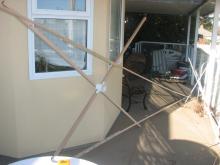Moxon Stuart on 17m
Moxon Stuart on 17m
I've built antennas for VHF, UHF, and the 220 MHz band, but always shrunk away from homebrew projects for the WARC, HF bands. VHF and up require antennas that are very managable size-wise, esp. if one remembers to keep their fingers off the soldering iron. It is fairly straightforward to both model and construct traditional yagis, quads, and j-poles for these bands.
HF antennas just seemed to demand too much building material, and too great a footprint in and above one's yard. That is, until I read L. B. Cebik's, W4RNL, web resource, which is probably one of the most thorough places on the 'net for antennas.
see: http://www.cebik.com/moxon/moxpage.html
On Cebik's page I spotted this weird design - a Moxon yagi, based upon Moxon rectangles. After loading the elements' measurements into the EZNEC antenna modelling software, then tweaking it with 2NEC4's modelling optimizer, I came up with a monoband project that could fit the constrains of the site here.
See the Moxon diagram (pictured) for the general layout of the two-element yagi, and see Cebik's page for other ingeneous dual band versions, including a 17M/30M dual-band Moxon yagi.
I decided upon a 17 meter band Moxon yagi, because it would sit on a frame measuring 23 feet 6.5 inches by 5 feet 2.125 inches, which could be relatively stealthy for our back yard, even up about 20 feet. The 17 meter band also is fairly open as the new sun-spot cycle begins in 2008.
It took two trips to the hardware store to assemble the material - 12 foot lengths of one-inch square Hemlock rod, two 9-foot lengths of hemlock 2x2, 3 inch PVC piping for a mast, some 1/8 inch by 2 inch bolts with washers and nuts, and about 60 feet of #11 galvinized wire for the elements. Some light plastic 1/4 x 1/4 inch rods keep the ends of the rectangle 62.125 inches apart.
The whole thing went together without too much problem, although I did under-estimate the size of the deck on which it was assembled. It went up onto the mast first try.
The modeling shows that this yagi is 1.4:1 right across the 17M band, and that is confirmed testing it with an analyzer. The modelling says that it gives 8.8 db in gain, has a 7.75 fr/back ratio, and has a fairly wide 40 degrees of gain from the front lobe. I can rotate (by hand) the antenna from the south to the northeast due to the position against the house. The antenna cannot be seen from our front street.
So far one contact with New Zealand has been made on it, and I am able to compare it side by side with a 40M Carolina Windom.
All in all a good experiment, even if it looks like the next stiff wind will blow it down. As a good ham friend says, if your antenna doesn't blow down, then it wasn't high enough!






